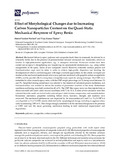JavaScript is disabled for your browser. Some features of this site may not work without it.
| dc.contributor.author | Nezhad, Hamed Yazdani | |
| dc.contributor.author | Thakur, Vijay Kumar | |
| dc.date.accessioned | 2018-10-10T14:03:10Z | |
| dc.date.available | 2018-10-10T14:03:10Z | |
| dc.date.issued | 2018-10-06 | |
| dc.identifier.citation | Hamed Yazdani Nezhad and Vijay Kumar Thakur. Effect of morphological changes due to increasing carbon nanoparticles content on the quasi-static mechanical response of epoxy resin. Polymers, 2018, Volume 10, Issue 10, Article number 1106 | en_UK |
| dc.identifier.issn | 2073-4360 | |
| dc.identifier.uri | https://doi.org/10.3390/polym10101106 | |
| dc.identifier.uri | https://dspace.lib.cranfield.ac.uk/handle/1826/13523 | |
| dc.description.abstract | Mechanical failure in epoxy polymer and composites leads them to commonly be referred to as inherently brittle due to the presence of polymerization-induced microcrack and microvoids, which are barriers to high-performance applications, e.g., in aerospace structures. Numerous studies have been carried out on epoxy’s strengthening and toughening via nanomaterial reinforcement, e.g., using rubber nanoparticles in the epoxy matrix of new composite aircraft. However, extremely cautious process and functionalization steps must be taken in order to achieve high-quality dispersion and bonding, the development of which is not keeping pace with large structures applications. In this article, we report our studies on the mechanical performance of an epoxy polymer reinforced with graphite carbon nanoparticles (CNPs), and the possible effects arising from a straightforward, rapid stir-mixing technique. The CNPs were embedded in a low viscosity epoxy resin, with the CNP weight percentage (wt %) being varied between 1% and 5%. Simplified stirring embedment was selected in the interests of industrial process facilitation, and functionalization was avoided to reduce the number of parameters involved in the study. Embedment conditions and timing were held constant for all wt %. The CNP filled epoxy resin was then injected into an aluminum mold and cured under vacuum conditions at 80 °C for 12 h. A series of test specimens were then extracted from the mold, and tested under uniaxial quasi-static tension, compression, and nanoindentation. Elementary mechanical properties including failure strain, hardness, strength, and modulus were measured. The mechanical performance was improved by the incorporation of 1 and 2 wt % of CNP but was degraded by 5 wt % CNP, mainly attributed to the morphological change, including re-agglomeration, with the increasing CNP wt %. This change strongly correlated with the mechanical response in the presence of CNP, and was the major governing mechanism leading to both mechanical improvement and degradation. | en_UK |
| dc.language.iso | en | en_UK |
| dc.publisher | MDPI | en_UK |
| dc.rights | Attribution 4.0 International | * |
| dc.rights.uri | http://creativecommons.org/licenses/by/4.0/ | * |
| dc.subject | polymers | en_UK |
| dc.subject | composites | en_UK |
| dc.subject | carbon nanoparticles | en_UK |
| dc.title | Effect of morphological changes due to increasing carbon nanoparticles content on the quasi-static mechanical response of epoxy resin | en_UK |
| dc.type | Article | en_UK |
Files in this item
The following license files are associated with this item:
This item appears in the following Collection(s)
-
Staff publications (SATM) [4367]

